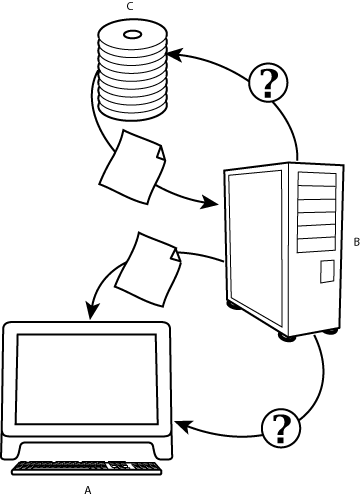 |
Web servers
Static Web pages can be viewed directly from the file system where the page is stored. You can use the GoLive Preview tab or a Web browser to directly view the file containing the Web page. Dynamic pages contain executable script code and must be processed by a Web server in order for you to see the page as the viewer would.
Thus, unlike static Web sites, you must upload your Web site and database to a Web server in order to create and preview dynamic Web pages in GoLive.
Simply put, a Web server is a program running on a computer sometimes known as the server host or server host computer. The Web server software sends Web pages to browsers, for example, when a viewer enters a Web address (URL) or clicks a link to a page on your site. A Web server is called that because it "serves" or sends the requested page back to a viewer's browser.
Note: Web servers are also sometimes distinguished by how they fit into your workflow. A server that is not open to the public, but designed for the internal testing of sites is called a staging server. The server where you place sites for public access is generally designated as a production server.
While you are working on a site, it is stored on your local computer or in the GoLive Workgroup server. You create and edit pages from there. In order to test the site, it must be accessed using a Web server so that the dynamic pages can be processed. This requires the pages to be uploaded to a staging or development server. (See Uploading and downloading files using FTP, Managing files and folders on a WebDAV server, and for information on publishing workgroup sites.) When you set up a site for dynamic content using the dynamic site wizard, GoLive attempts to upload files to the server you designate. The site cannot operate unless these uploads are successful.
The characteristics of staging and production servers differ.
In a staging server, the authoring and debugging capabilities of GoLive dynamic content are used, and support files for these capabilities are present in the site. Database contents are simulated data. For example, you may make purchases to test an e-commerce site but don't want to be billed and receive merchandise! Staging servers are internal and not open to the public.
In a production server, database contents are live production data, and open to the public. For information on security issues and production servers, see Making a dynamic site secure.
The Web server distinguishes between static and dynamic pages. It returns static pages by fetching the file that contains the page and sending its contents to the client, typically a browser. For dynamic pages, the Web server runs a program that interprets the contents of the page and sends the results (whether HTML, XML, image data, and so on) to the client. Because the dynamic page often contains commands written in a scripting language, this process is sometimes called server scripting.
